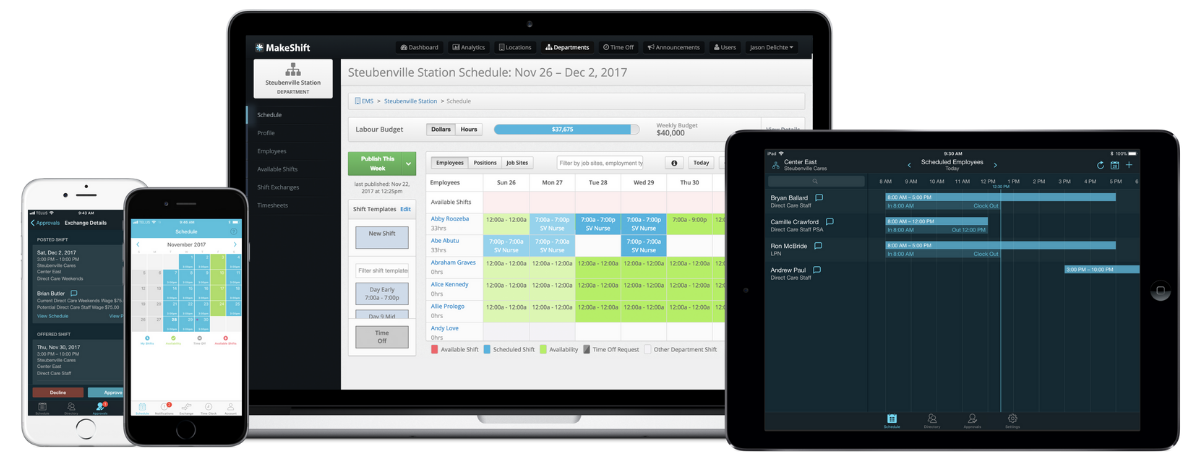Mental health is a hot topic for employees and business leaders alike these days.
But let’s face it: We still have a lot of work to do. A company culture that supports mental health is a must-have for employees – for good reason.
Good mental health is all about achieving a state of well-being where you're able to:
- Handle everyday stress
- Be productive at work
- Contribute to the community
Think about it—your employees’ mental health dramatically impacts their creativity, fulfillment, and productivity at work.
Did you know that depression and anxiety alone are why most people miss work days?
This article reveals the latest workplace mental health stats and discusses what it means for you and your company.
From handling a mental health crisis to strategies for creating a supportive work environment, we've got the lowdown on improving and prioritizing mental well-being at work.
- Mental Health in the Workplace
- Workplace Mental Health Stats
- How To Handle a Mental Health Crisis in Your Workplace
- Identifying & Handling Employee Mental Health Issues
- 5 Strategies To Support Employee Mental Health
- How to Craft and Implement an Employee Mental Health Policy
- MakeShift Scheduling: A Tool for Mental Health Support
- FAQ
Mental Health in the Workplace
Mental health is a hot topic these days — odds are it’s all over your social media feeds.
So, how do we define mental health?
We mean feeling good about what you can do, handling everyday stress, being productive, and helping out in your community.
In the workplace, it's about how an employee’s job and their company's vibe help them stay mentally fit.
Roughly 12 billion work days are lost each year to anxiety and depression, costing $1 trillion a year in lost productivity.
Workplace Mental Health Stats
The stats speak for themselves on the status of workplace mental health today.
- 92% of workers say working for a company that values their emotional and psychological well-being is important.
- 81% of workers in 2022 reported that workplace stress affects their mental health.
- Mental illness is the greatest cause of worker disability globally.
- Over half of all work-related illnesses are due to poor mental health. Roughly 51% of long-term sick leave is related to stress, depression, or anxiety.
- 64% of managers have considered quitting for a job that better supports their well-being.
- Almost 60% of employees worldwide have faced at least 1 mental health challenge in their lives.
- 87% of employees feel dread at least once a month — almost half experience it weekly. This is even higher among executives and CEOs. 55% & 59% report being filled with weekly work dread.
- In 2023, 91% of CEOs and 89% of employees agreed their company adequately supports mental health, a big jump from 2022.
How To Handle a Mental Health Crisis In Your Workplace
Before we get into prioritizing and improving employee mental health in the workplace, let’s address how to handle a crisis.
This is a pivotal moment.
And how you handle it says everything about your company culture and your organization’s attitude toward mental health.
Handling an employee's mental health crisis in the workplace requires a careful and supportive approach.
Follow these 11 steps to support your employee in crisis appropriately:
1. Spot the signs — Changes in behavior might indicate a mental health crisis and emotional distress.
We’ve listed a few signs to watch for:
- Irritability / Anger / Emotional outburst
- Fidgeting / Pacing / Inability to be still
- Sweating
- Labored breathing
✶An important note✶ — The signs won’t always be front & center. You might simply notice your co-worker seems off in some way. Trust your gut and pay close attention. If the signs are “quiet,” skip to step 3.
2. Assess the situation for danger — If the crisis poses an immediate threat to the employee or others, prioritize safety. You may need to call 911 or a mental health crisis team.
3. Provide support — If there’s no apparent danger, approach the employee non-confrontationally. Let them know you’re concerned and ask what they need to ease their symptoms. You could ask questions like:
- Do you need a drink of water?
- Would you like to go to a quieter space?
- Is there anybody I can call for you?
- How are you feeling right now?
4. Listen & empathize — Listening is your top priority in this step. Don’t advise on how to “fix” the problem. Just give them space to express what’s on their mind.
5. Offer assistance & resources — Inform the employee about available mental health resources, like EAPs, counseling services, mental health professionals, and mental health days available.
6. Respect privacy & confidentiality — Maintain confidentiality and respect the employee's privacy regarding their mental health condition.
7. Give them time to recover — Understand this. A mental health crisis is just like a physical crisis. Your employee will need time off to rest and recover — give them the time they need.
Let them know it’s ok, it’s normal. A bipolar episode, a panic attack, or a severe case of the flu is viewed the same in your organization. Offer mental health days to support your employees’ recovery.
8. Welcome them back — Let them take the lead when your employee returns to work. If they want to talk about the incident, be open and listen. If not, go back to work and engage with them as you did before.
9. Develop a support plan — Work with the employee, HR, and possibly their mental health professional to create a support plan. This might include accommodations like flexible work hours or workload adjustments.
10. Follow up regularly—Check in with the employee regularly (privately) to offer ongoing support and adjust the support plan as needed.
11. Foster a supportive workplace culture — Cultivate a workplace culture that’s open and supportive of mental health. Let employees know they can ask for help without fear of stigma or discrimination.
How do you squash the stigma?
Let’s say an employee with bipolar disorder has a manic episode at work that involves yelling, curse words, and disruptive behavior. Once the immediate crisis has been handled, they take time off to get treatment and recover.
While they’re gone, address the incident with your staff, speaking kindly and supportive about that employee. Check in on how your staff is feeling about what happened.
Not sure how to do that?
Imagine one of your employees had a massive heart attack at work in front of most of the staff. 911 was called, they were taken to the ER and will be home recovering for a while.
The incident was jarring and scary.
Talk about a mental health emergency just as you’d address the heart attack incident.
When your employee returns, don’t replay the episode for them (unless they want to).
They obviously weren’t in control.
For that matter, they’re probably embarrassed and concerned about keeping their job.
The best thing you can do is offer SUPPORT so they know they’re safe.
Remember, the goal is to help your employee manage their crisis while maintaining dignity and privacy.
Identifying & Handling Employee Mental Health Issues
Knowing how to handle an employee’s mental health crisis is essential. Better yet, learn to identify a struggling employee so you can offer proactive support and, hopefully, prevent a crisis.
1. Stay alert for any of these signs:
- Reduced productivity
- Frequent absenteeism
- Disengagement from team activities
- Mood swings
- Changes in typical behavior
2. Train leadership
Host regular training sessions for managers and team leaders on how to respectfully identify signs of mental distress in their team members.
This could include:
- Workshops on emotional intelligence & communication skills
- Training modules on mental health awareness & empathy
- Training on recognizing signs of mental distress & appropriate responses
3. Create a supportive response protocol
Develop a chronological protocol for your managers when identifying potential mental health issues. Emphasize confidentiality, empathy, and directing employees to appropriate resources rather than punitive measures.
5 Strategies To Support Employee Mental Health
The key to improving mental health in the workplace is having a solid plan.
Use these 5 strategies to foster a company culture that prioritizes employee well-being.
1. Encourage flexible work arrangements
Implement remote work options and flexible hours. For example, let employees start and end their work day at times that suit their personal commitments and energy cycles.
The presence of flexible work options has a direct correlation with better mental wellness.
According to FlexJobs, only 17% of workers with flexible work arrangements reported their mental health as poor, compared to 27% of those without work-hour flexibility.
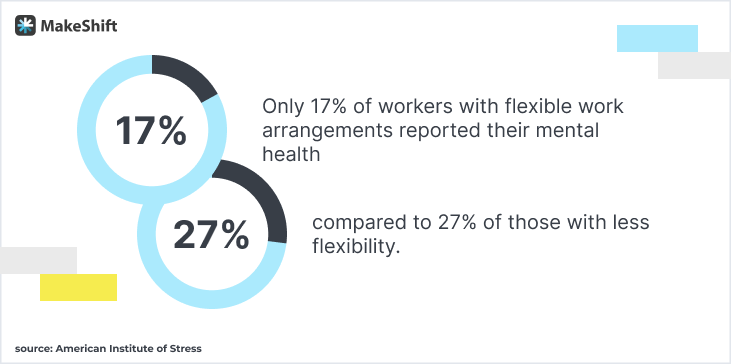
Mimecast is a company with a plethora of flexible work schedules. All roles come with the potential of being remote or having a customized work schedule.
Mimecast adopted hybrid working to support its employees with whatever work arrangements are best for them. It’s one of the top companies that offer flexible hours for moms.
2. Offer mental health days
Provide designated mental health days separate from sick leave. Employees can use these days when they feel overwhelmed and need a break for their mental well-being or if they suffer a mental health crisis like the example above.
A study by Mind Share Partners found that offering mental health days and encouraging their use reduced overall employee burnout.
PwC (a business advisory service firm) adopted a unique initiative to encourage mental health breaks. In 2022, they offered employees $250 each time they took a full week's vacation. They also have a program allowing workers to take up to 6 months off, during which they receive 20% of their pay.
This leave of absence program is part of PwC's commitment to supporting employees' mental wellness.
3. Foster an open dialogue about mental health
Organize regular mental health awareness workshops or online training modules and create safe spaces for employees to discuss their mental health challenges.
Encourage self-care, wellness, and time off.
Research indicates workplaces that encourage open conversations about mental health see a reduction in stigma and an increase in employees asking for help.
SAP® responded to an employee survey that revealed high stress levels by allocating a Mental Health Day.
This day is a company-sponsored global holiday where employees unplug from work and focus on their well-being. This initiative was part of SAP's broader commitment to prioritizing well-being in the workplace.
4. Create a supportive environment
Train managers to recognize emotional distress signs and provide them with tools to offer support. For example, EAPs, mental health apps, and counseling services.
Unfortunately, 1 in 3 employees feel support for mental health in their workplace is inadequate and would like more support from their employers.
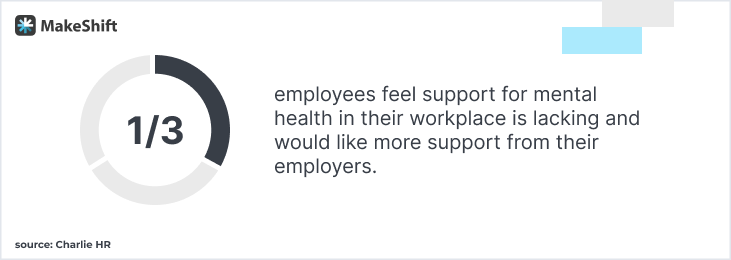
Hot Topic is a prime example of a company’s proactive approach to mental health.
Their approach includes:
- Comprehensive Employee Assistance Program (EAP) — Hot Topic provides EAP benefits to all employees, regardless of their location.
- Stress prevention & mindfulness practices — The company offers programs focused on stress prevention, mindfulness practices, and digital coaching.
- Supportive leadership — Their leadership encourages an environment where your team feels safe to express themselves, share feedback, and ask for what they need.
5. Offer access to mental health professionals
Establish a program that offers employees 24/7 direct access to mental health professionals. Include this program in your employee benefits packages in addition to mental health services.
Accomplish this through teletherapy or partnerships with local mental health organizations.
Not only does this help your employees in crisis (finding a good therapist or psychiatrist on short notice is extremely difficult), but it also helps close the treatment gap. Many people suffering from depression and anxiety receive no or inadequate treatment due to factors like income, socioeconomic status, and gender.
According to a report by the American Psychological Association, providing employees access to mental health services can lead to a 33% decrease in absenteeism and a 22% reduction in healthcare costs.
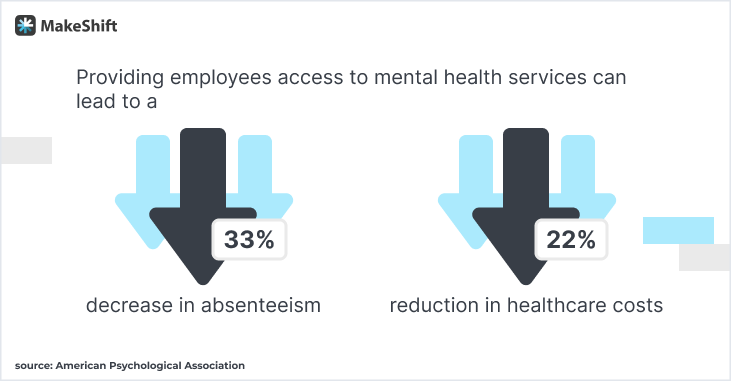
Expedia Group supports its employees' mental health by offering Talkspace, a 24/7 online therapy service, and an EAP.
These services provide FREE access to confidential counseling sessions, virtual therapy, and mindfulness programs. In addition, Expedia Group's medical plans include access to mental and behavioral health services.
How to Craft and Implement an Employee Mental Health Policy
Part of implementing an employee well-being initiative is drafting a mental health policy. Not sure where to start? Follow these 7 steps to get a stellar policy up and running:
1. Assess & research — Conduct an internal assessment to gauge employees' mental health climate and needs.
2. Involve employees — Form a diverse focus group to gather input and insights. Use surveys or meetings to understand wide-scale employee perspective.
3. Draft the policy — Define clear objectives and scope of the mental health policy.
Include elements like:
- Mental health crisis protocol
- Confidential support systems
- Mental health training programs
- Easily accessible resources
- Mental health leave stipulations
4. Provide confidential support—Establish confidential channels for employees to seek help without fear of stigma. Provide support through EAPs, teletherapy, or partnerships with mental health professionals.
5. Policy review and feedback — Once drafted, circulate the policy for feedback from various departments and employee reps. Revise based on received feedback.
6. Implementation — Communicate the policy to all employees. Implement the policy with the necessary support and resources.
7. Monitor & evaluate — Regularly monitor the effectiveness of the policy and make adjustments based on ongoing feedback and evolving needs.
How MakeShift Scheduling Helps Support Mental Health
MakeShift is all about making life easier for managers and employees. We know how mentally and physically draining it can be to juggle a schedule that doesn't fit your life.
At MakeShift, we put people first by streamlining schedule creation and management.
We’ve prioritized employee well-being by creating tools to make work fit around their lives, not vice versa.
We’ve chosen 3 areas to highlight MakeShift’s support of employee well-being:
- Balancing Workloads — MakeShift has a user-friendly interface for scheduling. Easy access reduces the stress of managing complex shift patterns, leading to better work-life balance for the whole team.
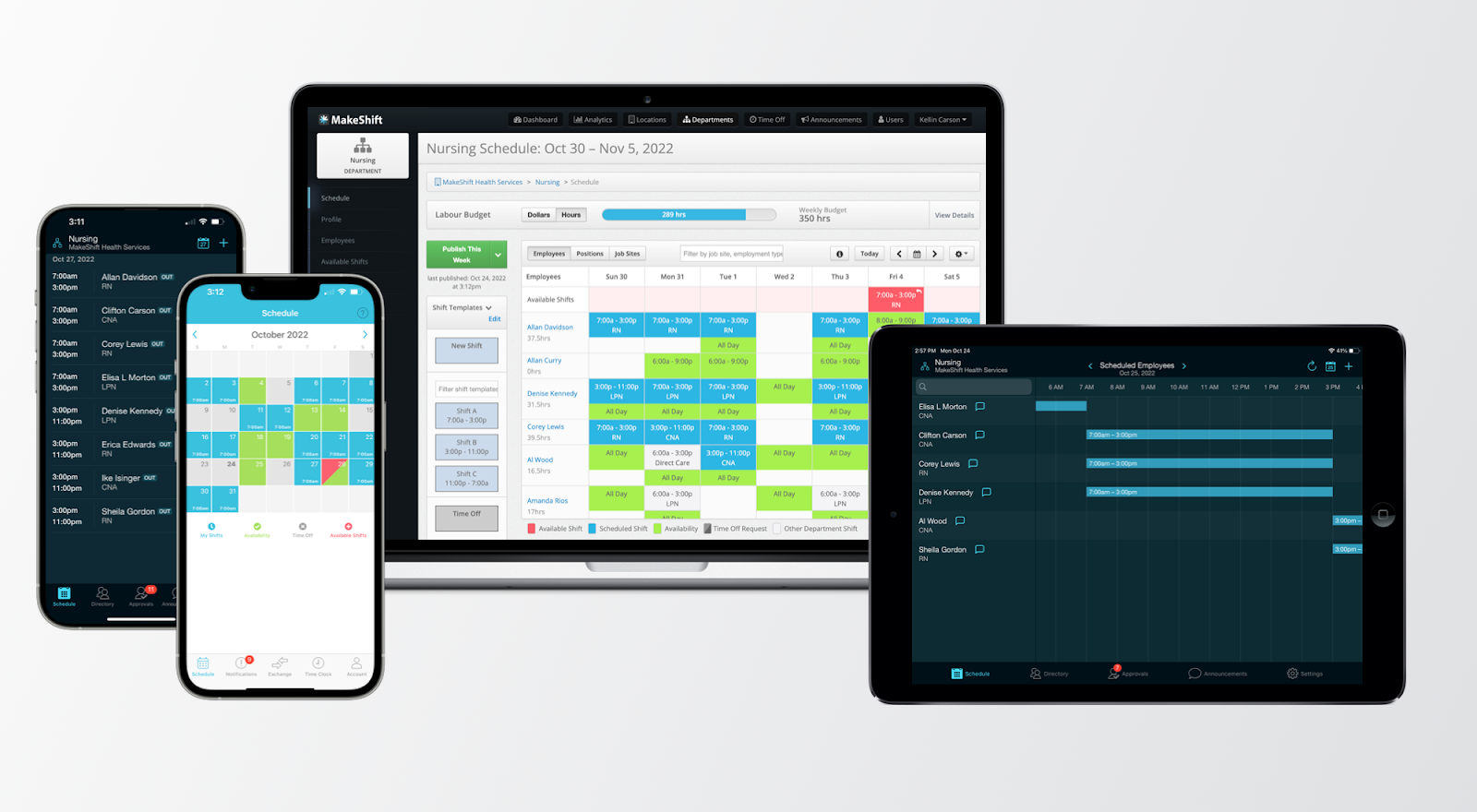
- Minimizing Stress — Our AI-powered scheduling platform offers 24/7 assistance. This empowers employees with the flexibility to get scheduling answers quickly whenever they need them, enhancing their sense of control and reducing anxiety.
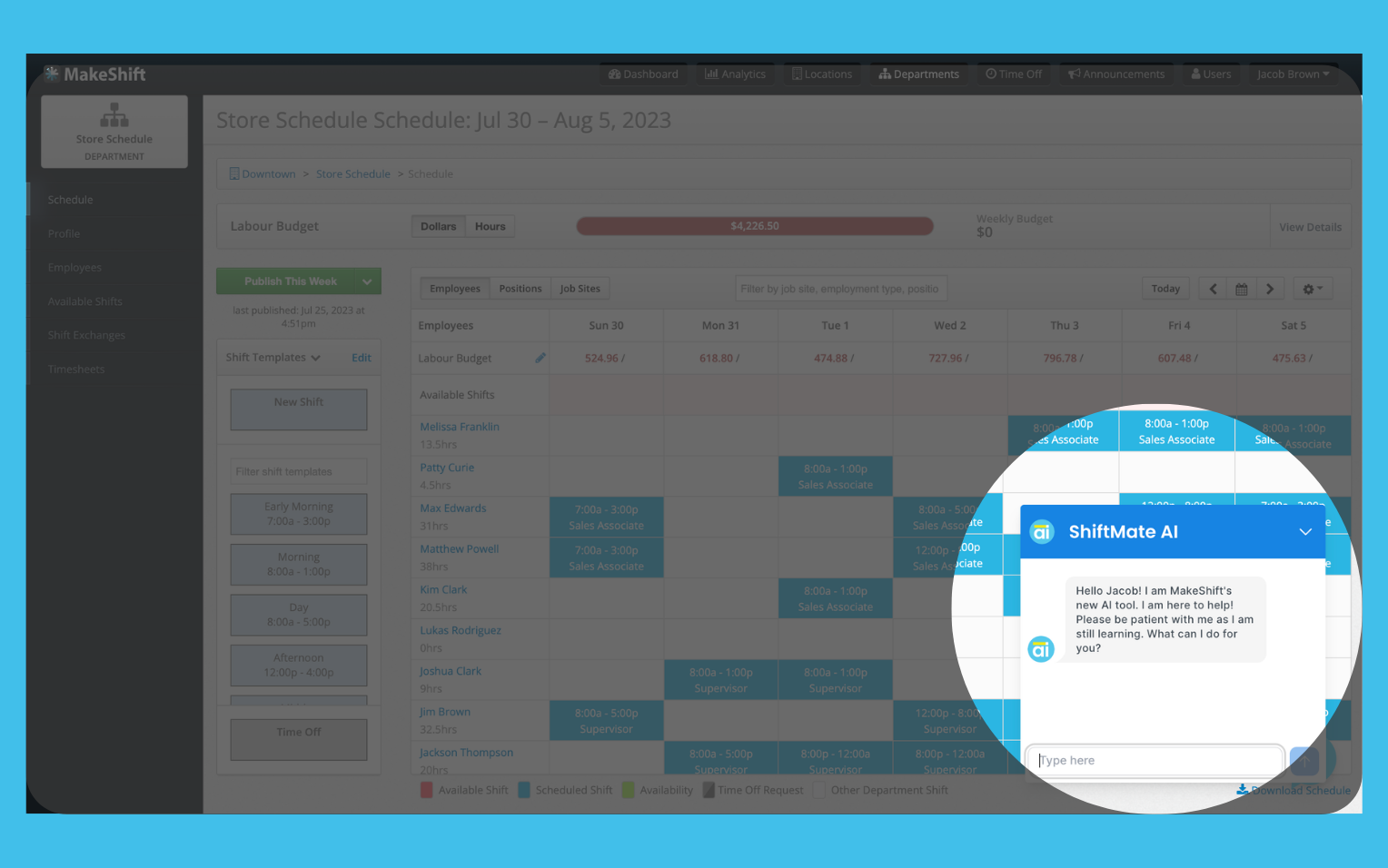
- People-First Scheduling — Automated scheduling based on employee preferences. Allowing employees to set their availability and quickly request time off conveys respect for personal time and commitments and contributes to better mental health.
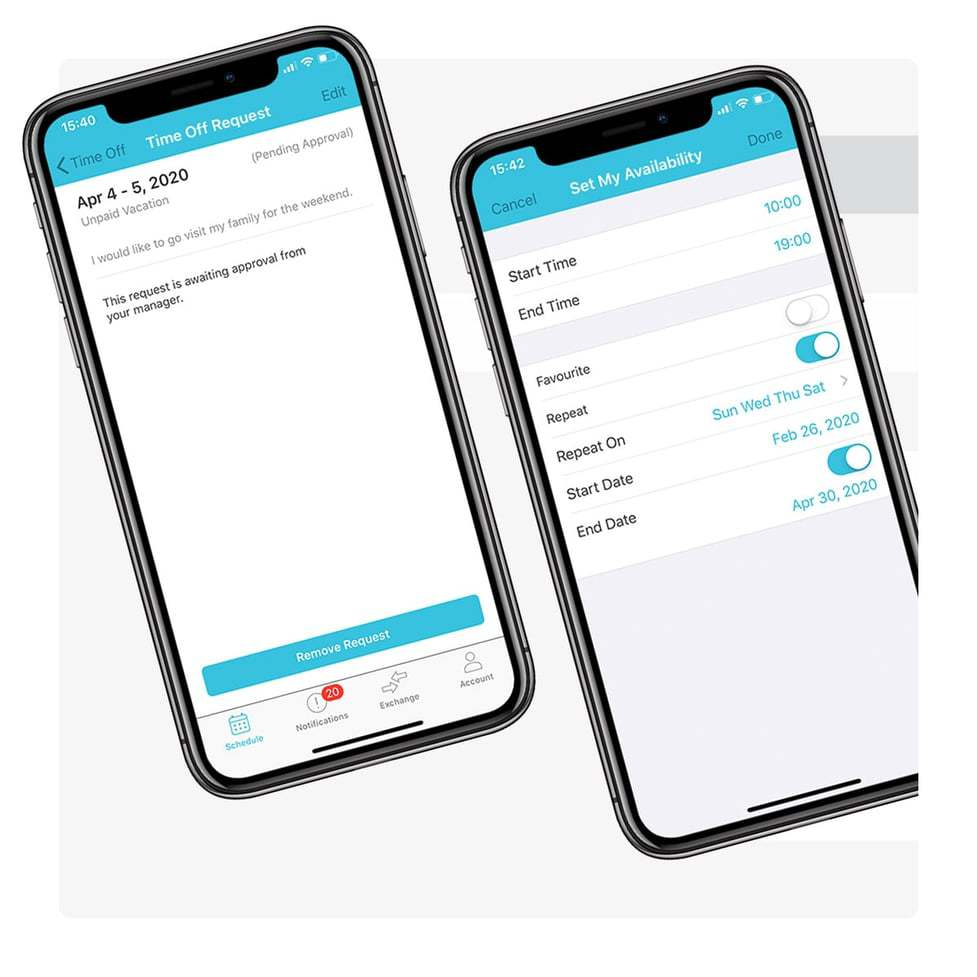
FAQ
How can I improve mental health at work?
Improving mental health at work involves several strategies. Managing stress is crucial, and techniques like deep breathing, mindfulness, or short breaks can help.
Maintaining a work-life balance is also essential, ensuring clear boundaries between your professional and personal life. Seeking support when you feel overwhelmed is critical, whether from coworkers, a manager, or a mental health professional.
Staying organized helps reduce anxiety and boost productivity. This includes keeping your workspace tidy and prioritizing tasks effectively.
Lastly, a healthy lifestyle with regular exercise, a balanced diet, and sufficient sleep significantly contribute to better mental well-being.
How can employers promote mental health in the workplace?
Employers can promote mental health by creating a supportive environment that encourages openness about mental health issues. Access to mental health resources like EAPs, counseling services, or wellness programs is essential.
Implementing flexible working hours or remote work options can help employees manage stress and improve work-life balance. It is also important to train managers to recognize and support mental health issues in their teams.
Additionally, encouraging regular breaks and using PTO can prevent burnout and promote overall mental health in the workplace.
What are the most common mental health issues in the workplace?
The most common mental health issues in the workplace include stress, often caused by high workloads, tight deadlines, or challenging relationships.
Anxiety can also arise from factors like job insecurity or performance pressures.
Depression in the workplace might be triggered by job dissatisfaction, feeling undervalued, or a lack of support.
Burnout (physical and emotional exhaustion) often results from prolonged stress and overwork. Substance abuse may also occur as a coping mechanism for work-related stress or other mental health challenges.
Employee Mental Health Matters
The days of looking the other way regarding an employee’s emotional well-being are long gone.
Your employees’ mental health is equally as important as their physical health — if you want healthier (& happier) employees, the former affects the latter.
Want your staff to enjoy their jobs, be productive, and stick around? Creating a company culture that prioritizes good mental health is an important step in the right direction.
At MakeShift, we’ve always led with a people-first approach. Ready to see how we can help you do the same? Schedule a FREE demo today.




